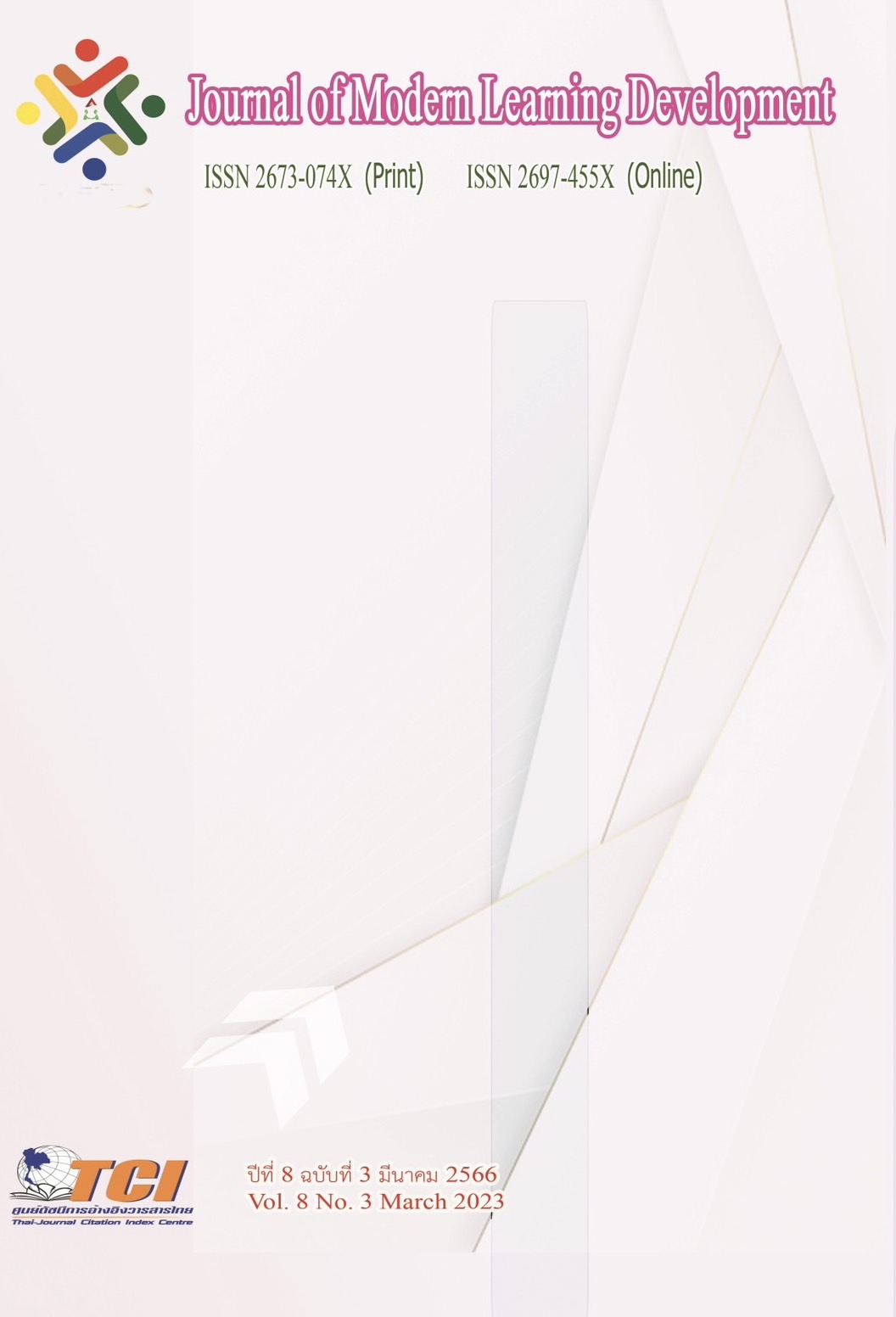The Guidelines for Managing the Happy Workplace, the Case Study of the Nong Bua Lamphu Provincial Police
Main Article Content
Abstract
The objectives of this research were 1) the components of happy workplace, and 2) to creating guidelines for happy workplace of the Nong Bua Lamphu Provincial Police. This research was a mixed method research that used qualitative research and quantitative research. Sampling groups were 315 samples, whom 15 important keys in the happy workplace form purposive sampling, and 300 respondents whom police officer under the Nong Bua Lamphu Provincial Police form convenience sampling. The data were collected by interview and questionnaires. The statistics used were percentage and exploratory factor analysis.
The following were the results:
- 1. the components of happy workplace for the Nong Bua Lamphu Provincial Police can classify 8 elements. There were (1) Have identity working, (2) Appropriate working environment, (3) Problem solving expertise, (4) Promote healthy family, (5) Your trust, (6) Compliment for outstanding performance, (7) Outcome of valuable income, and (8) Public concerned. The components of happy workplace was “HAPPY COP”.
- The guidelines for happy workplace of the Nong Bua Lamphu Provincial Police had 8 guidelines according by the components of happy workplace. That was guideline for further development of the happy workplace management guidelines of the Nong Bua Lamphu Provincial Police.
Article Details
References
ฉัฐวัฒน์ชัช ณฐาภัฏฐ์. (2564). การจัดการความปลอดภัยในการทำงาน กรณีศึกษา บริษัท สยามควอลิตี้ อินดัสทรี้ส จำกัด. วารสารวิชาการมนุษยศาสตร์และสังคมศาสตร์ มหาวิทยาลัยราชภัฏธนบุรี, 4 (1), 22-34.
กัลยา วานิชย์บัญชา. (2560). การใช้ SPSS for Windows ในการวิเคราะห์ข้อมูล. พิมพ์ครั้งที่ 29. กรุงเทพมหานคร: สามลดา.
กัลยารัตน์ ธีระธนชัยกุล. (2546). การบริหารทรัพยากรมนุษย์. กรุงเทพมหานคร: ปัญญาชน.
จิรา เติมจิตรอารีย์. (2550). ทำอย่างไรจึงจะอยู่อย่างมีความสุข. กรุงเทพมหานคร: คณะแพทยศาสตร์ มหาวิทยาลัยมหิดล.
ชาญวิทย์ วสันต์ธนารัตน์. (2553). เอกสารประกอบการสัมมนา Happy Workplace Forum แผนงานสุขภาวะองค์กรเอกชน. กรุงเทพมหานคร: สำนักงานกองทุนสนับสนุนการเสริมสร้างสุขภาพ (สสส.).
ฌานิกา วงษ์สุรีรัตน์. (2554). ความสัมพันธ์ระหว่างคุณภาพชีวิตการทำงาน ความสุขในการทำงาน โดยมีความเพลิดเพลินเป็นตัวแปรกำกับความสัมพันธ์: กรณีศึกษาบริษัทวิศวกรรมก่อสร้างนอกชายฝั่งแห่งหนึ่งในกรุงเทพมหานคร. วิทยานิพนธ์ปริญญาศิลปศาสตรมหาบัณฑิต. คณะศิลปศาสตร์: มหาวิทยาลัยธรรมศาสตร์.
ทศพล ชัยสัมฤทธิ์ผล (2562). จิตแพทย์ชี้ หากตำรวจคิดฆ่าตัวตาย มักประสบความสำเร็จสูงกว่าคนใน
อาชีพอื่น. สืบค้นเมื่อ 21 สิงหาคม 2565, จาก https://www.bbc.com/thai/thailand-46744797
ประทุมทิพย์ เกตุแก้ว. (2551). ความสัมพันธ์ระหว่างการรับรู้คุณลักษณะงาน ความสามารถในการเผชิญและฟันฝ่าอุปสรรคกับความสุขในการทำงานของพยาบาล งานการพยาบาลผ่าตัด : กรณีศึกษาโรงพยาบาลรัฐแห่งหนึ่ง. (รายงานการวิจัย). กรุงเทพมหานคร: คณะศิลปศาสตร์ มหาวิทยาลัยธรรมศาสตร์.
มาลิณี อ้นวิเศษ. (2554). ความสัมพันธ์ระหว่างคุณลักษณะของงาน อุปนิสัย 8 ประการ รูปแบบการบังคับบัญชาของหัวหน้างาน การรับรู้การสนับสนุนจากองค์การกับความตั้งใจที่จะลาออก ของเจ้าหน้าที่บริการลูกค้าในธนาคารพาณิชย์แห่งหนึ่ง เขตกรุงเทพมหานคร โดยมีความผูกพันเป็นตัวแปรสื่อ. วิทยานิพนธ์ปริญญาศิลปศาสตร์มหาบัณฑิต. คณะศิลปศาสตร์: มหาวิทยาลัยธรรมศาสตร์.
สภาอุตสาหกรรมแห่งประเทศไทย. (2557). ความหมายและขอบเขตของคำว่า “สวัสดิการ”. สืบค้นเมื่อ 21 สิงหาคม 2565, จาก https://ftiweb.off.fti.or.th/intranet/file/banner/welfare.pdf
สมคิด ปิ่นทอง, 2556). รูปแบบการจัดการการกีฬาแห่งประเทศไทยให้เป็นองค์กรแห่งความสุข. วิทยานิพนธ์ปริญญาดุษฎีบัณฑิต. บัณฑิตวิทยาลัย: มหาวิทยาลัยเกษตรศาสตร์.
สุธาสินี ฤทธิศาสตร์. (2563) การศึกษาปัจจัยที่ส่งผลต่อความเครียดในการปฏิบัติงานของข้าราชการและบุคลากร สำนักงานตรวจสอบภายใน. (รายงานการวิจัย). กรุงเทพมหานคร: สถาบันพัฒนาข้าราชการกรุงเทพมหานคร.
สุธินี ฤกษ์ขำ. (2564). การจัดหาทรัพยากรมนุษย์เชิงกลยุทธ์ในยุคพลิกผัน. กรุงเทพมหานคร: สำนักพิมพ์จุฬาลงกรณ์มหาวิทยาลัย
Comrey, A. & Lee, H. (1992). A First Course in Factor Analysis. Hillsdale: Erlbaum.
Herzberg, F. (1959). The Motivation to work. 2nd ed. New York: John Wiley and Son.
Jacobs, J. A. & Gerson, K. (2004). The time divide: Work, family, and gender inequality. Cambridge, MA: Harvard University Press.
Sekaran, U. & Bougie, R. (2016). Research Methods for Business. (7th ed). Hoboken, NJ: John Wiley & Sons.


